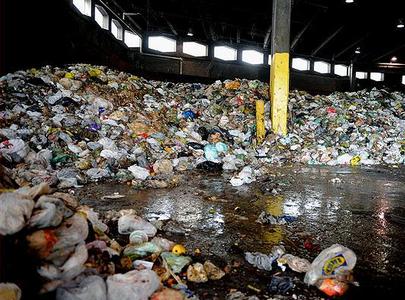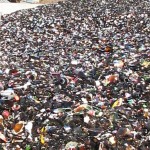 The church of recycling and the cult of organic composting was dealt another hard blow recently, when the Toronto Star conducted the following in-depth investigation, which was sent to me by my indefatigable friend Redmond. (Vote Redmond on October 25th, 2010!)
The church of recycling and the cult of organic composting was dealt another hard blow recently, when the Toronto Star conducted the following in-depth investigation, which was sent to me by my indefatigable friend Redmond. (Vote Redmond on October 25th, 2010!)
Green bins: A wasted effort?
Deep flaws mar recycling program as tons of organics end up in landfills or are turned into compost so toxic it kills plants
The City of Toronto boasts that its green bin program diverts a third of our garbage and turns it into “black gold” compost. But a Star investigation shows that the program – although nobly conceived – is a sham.
There are two problems. First, the city’s claim of how much waste the program diverts from landfill is inflated. Second, some of the compost that is being produced will kill your plants because of its high salt content, according to laboratory tests.
The Star found that, over the past two years, thousands of tons of organics in various stages of the composting process have been dumped into a gravel pit, tossed into landfills or stockpiled on city property. What’s more, some of the material residents are told to place in green bins – plastic bags and diapers – has wound up in the belly of a Michigan incinerator, despite Mayor David Miller’s vow Toronto will never burn garbage.
City residents deserve better, say compost experts. At least $15 million of taxpayers’ money goes to truck and treat the organic waste.
“Toronto homeowners put a lot of time and energy into separating their kitchen organics,” says Jim Graham, chair of the Ontario Waste Management Association.
“Residents have the right to expect the processors to do their job – and to create high-quality compost of consumer grade that they can use on their gardens.”
Toronto Mayor David Miller was too busy with the strike to comment, a spokesman told the Star on Thursday.
Geoff Rathbone, the city official in charge of the organic program, told the Star what happens to the organic matter “is not of concern to us” because it’s the provincial Ministry of the Environment’s job to enforce standards on processors.
The green bin program began in 2002, and today 510,000 Toronto homeowners dutifully separate garbage and put the organic waste into green bins for curbside pickup.
Compared to the pure organic programs in Durham and Peel regions, Toronto’s was flawed from the start. After public consultations, the city chose the simplest system for homeowners, encouraging plastic bag liners and the inclusion of diapers, neither of which can be composted.
The city proudly states that the compost it produces is “safe to use in gardens and lawns.”
Tests conducted for the Star by A&L Canada, a leading agricultural laboratory, found serious problems with compost produced by two separate companies contracted by the city to process the organic waste.
In one case, the lab found the compost was unfinished, meaning it was rushed through the process, in which micro-organisms break the waste down into a high-nutrient soil conditioner.
In the second case, the sodium content of compost given out at Toronto’s Environment Days was so high that it would kill plants. (More curing time would have removed naturally occurring sodium in vegetables and the salt we add to food.)
The Star also looked at the city’s so-called “diversion rate,” the markers by which recycling programs are judged. Critics say Toronto’s one-third rate is inflated.
Miller’s re-election promise in 2006 vowed to ramp up diversion rates to 70 per cent by 2010, so there’s pressure on the city to claim the highest possible rate.
Toronto’s annual output of 120,000 tons of organics has created a mad scramble for processors. In each of 2007 and 2008, the city shipped 1,000 truckloads to Quebec. By the time the green bin waste arrived, locked inside plastic bags the city wants residents to use, it was sometimes so rotten it went straight to landfill, says Quebec’s environment ministry. Some processors can’t handle liquefied rotten material.
That burns Councillor Denzil Minnan-Wong, who has spent years trying to track the organic waste. “We have an unwritten rule with the public that the green bin system will have integrity, and the materials they put in the bins will be reused in a meaningful way,” Minnan-Wong says.
“When the food ends up landfilled, or when the compost is toxic, then you are betraying the principles and the reasons why we have this program to begin with.”
Two major compost processors hired by the city to handle the waste – such as leftover steak, banana peels and all those diapers – have been hit with provincial restrictions due to neighbourhood odour complaints.
Within the past two months, before the municipal garbage strike began, Orgaworld Canada in London was severely limited in the amount of organics it could process while Universal Resource Recovery in Welland was shut down entirely. Follow the trail of Toronto’s organics, and the flaws in the system emerge.
The Star found that Orgaworld, which processes about 40 per cent of Toronto’s organic waste, has been sending thousands of tons of “residual” plastics to be burned in Detroit. It turns out about one-fifth of Toronto’s organic output is being burned or buried in landfills.
The city tells residents to put diapers into their green bins.
Graham of the Ontario Waste Management Association also owns Try-Recycling in London. He said the diapers are considered diverted when placed in the compost stream, but are immediately screened out. “Makes for good diversion numbers, but they end up in the landfill anyway,” he said.
Add to that the plastic Toronto wants homeowners to line their bins with. In Durham and Peel, residents are told to buy compostable bags.
Toronto has built a multi-million-dollar system that is sup posed to separate organic waste from non-compostable plastic bags. (It is also planning two new local processing facilities, at a cost of roughly $65 million, using the same technology.) But plastics make the food rot quickly, causing odour problems for processors, and large shreds of plastic end up in the compost.
Nobody wants to see the green bin program scrapped, just made better. Susan Antler, executive director of the Composting Council of Canada, says some municipalities, such as Durham, are “shining stars.” They impose strict limits – no plastic bags, no diapers, and no dog feces and kitty litter. (The latter two are both allowed in Toronto, with feces contributing to odour issues and kitty litter putting clay into the compost.)
“Garbage in means garbage out,” Antler says.
Orgaworld founder Henk Kaskens, who is based in the Netherlands, came to London, Ont., last month to deal with “the fuss” created when the environment ministry ordered Orgaworld to limit its daily intake of green bin material to five trucks, or about 150 tons. Before that it was taking about 1,000 tons a day. (The order was lifted recently, but a new investigation is underway.)
The environment ministry says it has logged 170 odour complaints against Orgaworld since January.
At the same time the ministry hit Orgaworld with the limits, it closed down the second largest processor of Toronto’s organic waste, Welland’s Universal. The ministry told Universal it had logged 120 complaints of odours such as smells akin to “vomit” or “dead animals” since the facility opened last fall.
Toronto was caught in a vice, with nowhere to turn, because all but one of its other processors were facing ministry limitations or Environment Act charges.
Universal general manager Gerald Pratt said his company is taking the odour issues very seriously and is working very hard to fix the problems at the plant.
The problem caused Toronto to stockpile 3,000 tons of organics in city transfer stations – long before the strike began.
Orgaworld’s Kaskens, who said he makes “the best compost in Ontario,” invited the Star for a tour of his plant. He said the odour problems resulted from ducts that crashed from the walls to the floor because a subcontractor had not properly fastened them. He complained the environment ministry is too enforcement-focused and scares away future investments.
Inside the cavernous plant are huge piles of food waste, plastic bags ripped open. Kaskens said his technology turns organics into compost in just 12 to 14 days. The ministry requires it be held another 21 days, but “it is not necessary.”
The Composting Council’s Antler and numerous other industry leaders said they have never heard of compost that can be finished in 12 days. It takes up to six months to cure compost, Antler said. Kaskens pointed out the piles of residual waste, the plastics, in his plant. He said they are trucked to Detroit for incineration.
Neither the city nor compost companies could put a firm figure on the amount of non-organic residuals that are burned or landfilled, giving figures that vary from 15 to 22 per cent and higher.
Welland’s Universal general manager Gerald Pratt put it at 26 per cent, primarily plastic shopping bags. Toronto’s organic waste has a “great deal of contaminants in it,” Pratt wrote in a June letter to a Michigan landfill he hoped would help him after his plant closed.
The Michigan landfill’s manager, Dan Gudgel, said in an interview he could not compost Universal’s organics because the contamination meant it would take too long to get Michigan government approvals.
“I hear you have a state of emergency up there,” he said.
Article by Moira Welsh

